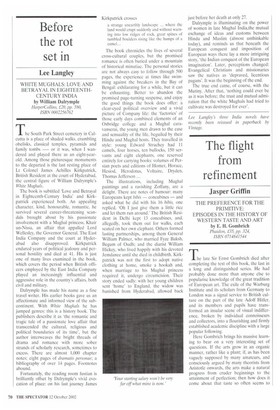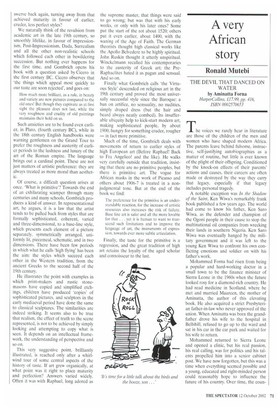The flight from refinement
Jasper Griffin
THE PREFERENCE FOR THE PRIMITIVE: EPISODES IN THE HISTORY OF WESTERN TASTE AND ART by E. H. Gombrich Phaidon, £35, pp. 324, ISBN 0714841544 he late Sir Ernst Gombrich died after completing the text of this book, the last in a long and distinguished series. He had probably done more than anyone else to popularise knowledge of the great tradition of European art. The exile of the Warburg Institute and its scholars from Germany to London was a signal service to British culture on the part of the late Adolf Hitler, and its members and pupils have transformed an insular scene of visual indifference, broken by individual connoisseurs and collectors, into a flourishing and firmly established academic discipline with a large popular following.
Here Gombrich brings his massive learning to bear on a very interesting set of questions. If the arts grow in an organic manner, rather like a plant; if, as has been vaguely supposed by many amateurs, and consciously argued by many theorists from Aristotle onwards, the arts make a natural progress from cruder beginnings to the attainment of perfection; then how does it come about that taste so often seems to
swerve back again, turning away from that achieved maturity in favour of earlier, cruder, less perfect styles?
We naturally think of the revulsion from academic art in the late 19th century, so smoothly lifelike, in favour of impressionism. Post-Impressionism, Dada, Surrealism and all the other non-realistic schools which followed each other in bewildering succession. But nothing ever happens for the first time, and Gombrich opens his book with a question asked by Cicero in the first centtny BC. Cicero observes that 'the things which appeal most quickly to our taste are soon rejected', and goes on:
How much more brilliant, as a rule, in beauty and variety are new pictures compared to the old ones! But though they captivate us at first sight the pleasure does not last, while the very roughness and crudity of old paintings maintains their hold on us.
Such anxieties are to be found even earlier, in Plato, (fourth century BC), while in the 18th century English handbooks were warning gentlemen on the Grand Tour to prefer the roughness and austerity of earlier periods to the lushness and luxury of the art of the Roman empire. The language brings out a cardinal point. These are not just matters of artistic preference: they are always treated as more moral than aesthetic.
Of course, a difficult question arises at once. 'What is primitive'? Towards the end of an exhilarating scamper through many centuries and many schools, Gombrich produces a kind of answer. In representational art, he argues, it is a law that the artist tends to be pulled back from styles that are formally sophisticated, coherent, varied and three-dimensional, to a base-line style, which presents each element of a picture separately, symmetrically arranged, uniformly lit, piecemeal, schematic, and in two dimensions, There have been few periods in which what he calls 'high flying' has been the aim: the styles which succeed each other in the Western tradition, from the ancient Greeks to the second half of the 19th century.
He illustrates the point with examples in which print-makers and rustic stonemasons have copied and simplified etchings, children have produced 'copies' of sophisticated pictures, and sculptors in the early mediaeval period have done the same to classical sculptures. The similarities are indeed striking. It seems also to be true that realism, the effect of truth to the scene represented, is not to be achieved by simply looking and attempting to copy what is seen. It depends on an intellectual framework, the understanding of perspective and
SO OR.
This very suggestive point, brilliantly illustrated, is reached only after a whirlwind tour of some central aspects of the history of taste. If art grew organically, at what point was it right to place maturity and perfection? Answers varied widely. Often it was with Raphael, long adored as the supreme master, that things were said to go wrong; but was that with his early works, or only with his later ones? Some put the start of the rot about 1520; others put it even earlier. about 1400, with the waning of the Age of Faith. The German theorists thought high classical works like the Apollo Belvedere to be highly spiritual. John Ruskin thought it utterly unspiritual. Winckelmann recalled his contemporaries to the austerity of Greek art; the PreRaphaelites hated it as pagan and sensual. And so on.
Finally what Gombrich calls 'the Virtuous Style' descended on religious art in the 19th century and proved the most universally successful style since the Baroque: a ban on artifice, no sensuality, no nudities, simply draped dress (but the hair and beard always neatly combed). Its insufferable ubiquity help to kick-start modern art, making sophisticated people, by about 1900, hungry for something cruder, rougher — in fact more primitive.
Much of the time, Gombrich deals with movements of return to earlier styles of high European art (Before Raphael! Back to Fra Angelico! and the like). He walks very carefully outside that tradition, insisting that there are no primitive peoples, but there is primitive art. The vogue for African masks in the work of Picasso and others about 1906-7 is treated in a nonjudgmental tone. But at the end of the book we find:
The preference for the primitive is an understandable reaction, for the increase of artistic resources also increases the risk of failure. Base line art is safer and all the more lovable for that . . yet it is human to want to transcend such limitations and to improve the language of art, the instruments of expression, towards ever more subtle articulation.
Finally, the taste for the primitive is a regression, and the great tradition of high art retains the loyalty of the aged scholar and connoisseur to the last.



































































































 Previous page
Previous page